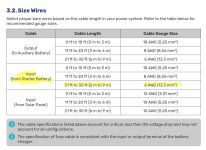The rest of the world is metric, including for wire conductors, so it makes sense.
This is a useful tool.
VOTLAGE DROP = [cable length (in metres) X current (in amps) X 0.0164] divided by cable cross-section in mm.sq
Of course, it is worth understanding why you would consider a DC-DC charger.
They are excellent devices for correcting the losses of voltage due to long cable runs with smaller than optimum cable sizes.
If you can use cable large enough to keep voltage drop under control, why would you need a DC-DC charger?
Don't forget that as the current decreases, so does the voltage drop.
I don't use a DC-DC charger.
I charge my house battery directly from the alternator and have done so for decades, both with AGM batteries and now with LiFePO4.
Cheers,
Peter
OKA196 motorhome


